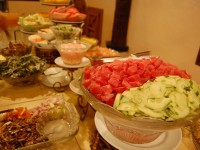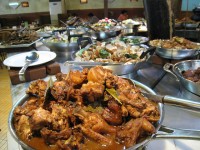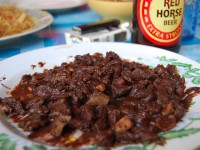 the Travel Enthusiast
the Travel Enthusiast
- 05 Dec
Edina in Food Experiences | NO COMMENTSA guide to Philippine cuisine
The Philippines is a bewildering place which for many travelers is still a mystery, a large blank chunk on the map. The second largest archipelago in the world contains no less than 7000 islands, and to visit all of them could be a lifetime’s endeavor.
There’s a whole lot of Philippines to see, which is all the more reason to see it, or taste it – after all, one of the ways to get to know a country is through its cuisine. Philippine cuisine is one of the least spicy cuisines in Asia, but it is far from bland!
The most common meals in the Philippines have their roots in various Asian, European and indigenous recipes and styles of cooking, which makes them truly unique. For the hungry traveler in the Philippines, here’s a guide to Philippine cuisine.
Pinakbet
Although initially a dish of the Northern Philippines, commonly eaten by the Ilocano people, pinakbet is so good that it spread all over the islands and you can find it mostly anywhere. This stew-like dish is made with loads of veggies (bitter melon, eggplant, tomato, okra, string beans, chili peppers, parda, winged beans to count only a few). It is considered really healthy, and a symbol of Ilocano culture.
Bibingka
If you’re in Philippine during the Christmas season, you’ll be seeing a lot of Bibingka, a typical Christmas dish. Bibinkga comes in countless regional variations, but most cake bases are made with rice flour and coconut milk, baked in banana leaves.
Some types of Bibingka might seem strange for western palates, for example the popular Bibingka Galapong, served with grated cheese and salted duck’s eggs.
Dinuguan
Vegetarians and meat-eaters with delicate constitutions will probably run away at the sight of Dinuguan, a popular Philippine dish made with…pig’s blood. Dinuguan is also called chocolate meat, because it looks similar to a pot of melted chocolate, but this stew is actually made with pig’s blood, meat, and pig innards, well seasoned with spices.
Adobo
If the Philippines should have a national dish, then it most certainly is adobo. Adobo is actually an indigenous cooking technique, which involves stewing the ingredients in vinegar.
The most common types of adobo are pork, chicken or a combination thereof, served with rice both at feasts and regular meals. Adobo is so popular that you can find all sorts of snacks and nibbles that are adobo-flavored, without them having any connection to adobo.
- Flights
- Hotels
- Packages
- Cars
- Cruises
travel search by Travelgrove (get this widget)Kare-kare
If you’re attending a Philippine fiesta, you’re bound to encounter kare-kare, one of the traditional party dishes in the Philippines. The prime ingredient of this stew is oxtail, ox tripe, peanuts, rice and vegetables like eggplants, string beans, cabbage and banana flower buds. The usual accompaniment for kare-kare is bagoong, dollops of shrimp paste.
You might also like




